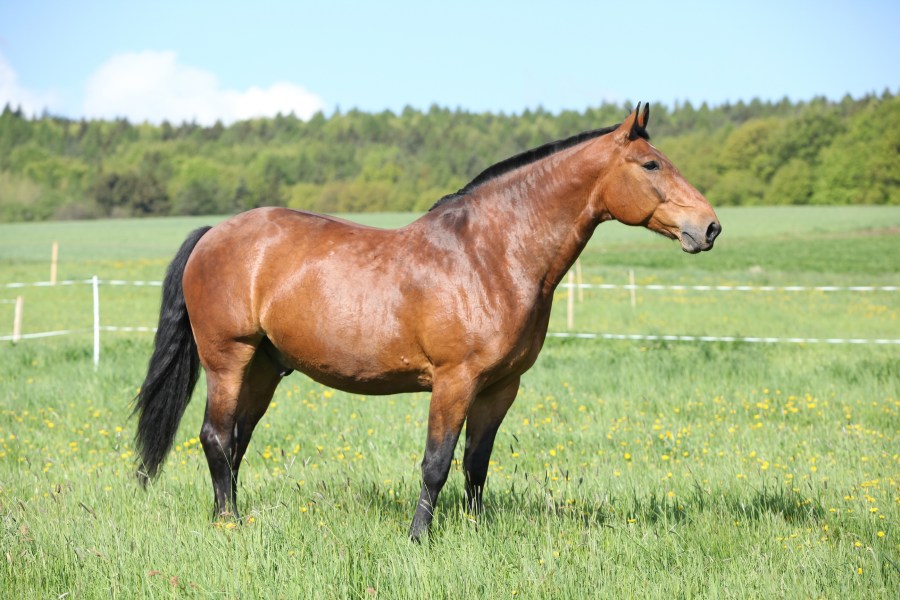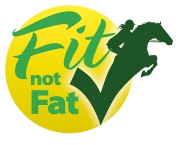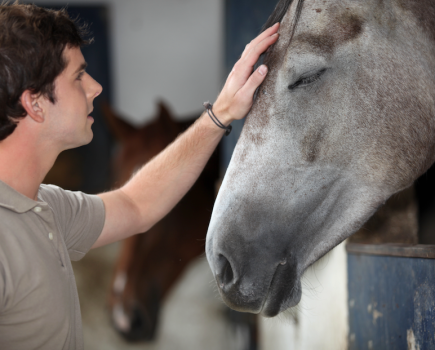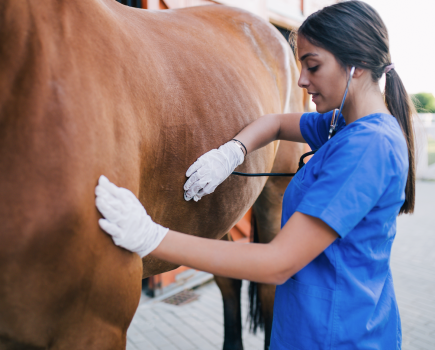Your Horse’s #FitNotFat is brought to you in partnership with Dengie Horse Feeds
As the seasons change, inevitably a hot, dry summer gives way to a wetter autumn which can result in another seasonal flush of grass. Whilst for those with poor doers who struggle to maintain their weight this can be very welcome, for those of us with good doers that are also laminitis prone it can be of real concern.
The main cause of laminitis is hyperinsulinemia associated laminitis (HAL), which is associated with the endocrine disorders Equine Metabolic Syndrome (EMS) and Pituitary Pars Intermedia Dysfunction (PPID or Cushing’s disease).
EMS is a metabolic problem characterised by insulin dysregulation (ID), abnormal adipose (fat) distribution (e.g. cresty neck and fatty pads) and altered levels of adipokines or fat hormones.
PPID is a degenerative endocrine disorder that disrupts the control of hormones produced in the pituitary gland and commonly affects older horses and ponies.
Individuals can have EMS, PPID or both conditions at the same time.
Insulin dysregulation
Diet has a key role to play in managing insulin dysregulation. The key things we can do to manage laminitis risk in our susceptible horses are:
- Aim to keep your horse at a healthy weight and encourage weight loss if overweight.
- Manage the intake of non-structural carbohydrates (NSC), as those with underlying insulin dysregulation have an abnormal response to the intake of NSC.
- These equines produce more insulin and insulin levels remain raised for longer. This is significant as it is these higher circulating levels of insulin that are thought to link to laminitis risk.
- Manage the rate of intake of forage and feed, as a slower rate of intake helps to reduce the insulin response to eating.

Why laminitis risk increases in autumn
There are several reasons why susceptible horses may be at an increased risk of laminitis in the autumn months, including:
More grass
With the seasonal flush of grass there can be more grass to eat, which can result in rapid weight gain.
Sunny days
Sunny days can still result in higher levels of non-structural carbohydrates in the grass. Because there is more grass to eat, your horse will therefore consume higher levels of non-structural carbohydrates.
Colder nights
Late autumn in to winter we may start to see sunny days and frosty nights, which means the grass accumulates non-structural carbohydrates during the day, but can’t use it to grow overnight as it is too cold.
This means non-structural carbohydrate levels in the grass become even higher again.
Seasonal hormonal changes
There are hormonal changes at this time of year, which mean that those equines that were previously not known to be at risk of laminitis may now be at risk.
Adrenocorticotrophic hormone (ACTH) can be measured in the horse’s blood and is used to identify the incidence of PPID. Naturally, ACTH levels rise in all horses in the autumn, but for those with PPID, the levels are particularly high.
Testing in the autumn using seasonally-adjusted reference ranges is therefore recommended as a good time to identify PPID. Those testing positive should also be tested for insulin dysregulation, as those with PPID and insulin dysregulation together are at the greatest risk of laminitis.
Managing grass intake
If your horse is laminitis prone, the autumn months mean that you still need to monitor them regularly and manage their grass intake accordingly.
Strip grazing and grazing muzzles can be used to manage grass intake to help to keep your horse at a healthy weight.
However, if they are particularly susceptible to laminitis, it may be more appropriate to remove them to a grass free area for a greater control over what’s going in.
Suitable forage
When a horse is removed from grass, their reliance on conserved forage increases.
As such it is also important that the conserved forage used provides an appropriate amount of energy to help keep your horse at a healthy weight and is also low in non-structural carbohydrates to help manage laminitis risk.
The general consensus when selecting forages is to aim for less than 10%-12% non-structural carbohydrates on a dry matter basis, although some individuals severely affected by insulin dysregulation may require even less.
Non-structural carbohydrates
Non-structural carbohydrates (NSC) is an analytical term. It is the sum of water soluble carbohydrate (WSC) and starch added together.
Water soluble carbohydrate is a measure of simple sugar plus fructan.
The NSC of forage can be highly variable according to environmental conditions during growth and at the time of harvest.
For example, hay that’s cut on a cloudier day or earlier in the morning is likely to be lower NSC compared to hay that’s cut in the afternoon on a sunny day.
The only way to know how much NSC your forage contains is to get it tested.
If testing your hay isn’t practical, as your supply changes regularly, then soaking your hay can reduce the level of WSC and therefore NSC.
Results can be highly variable and so soaking shouldn’t be relied upon to make a hay that is high in NSC safe.
Generally, though, the greater the volume of water, the longer the soak time, and the warmer the water, the greater the losses of WSC will be.
However, it is important to remember that as we head into the colder winter months, soaking hay may not continue to be practical as taps and water buckets freeze, and the yard becomes like an ice rink when you try to dispose of the used water.

Feeding straw
Providing your horse has normal dentition, and providing it is introduced gradually to allow time for the digestive system to adapt, it can be useful to think ahead and start to blend straw into your horse’s usual forage ration in the autumn, just in case you can’t soak your hay through the winter.
Not only can it help to reduce your horse’s calorie intake if they are a good doer or need to lose weight, but it can also help to reduce your horse’s NSC intake as straw is lower in NSC than grass.
Additionally, mixing straw though the usual forage ration has the added advantage of slowing the rate of intake of the entire forage meal.
This is particularly beneficial for those with insulin dysregulation, as the slow rate of intake reduces the insulin response to eating.
Energy value in forage
Up to 50% of your horse’s usual forage ration can be replaced by straw. When using typical energy values for straw and average hay, replacing 50% of hay with straw can reduce energy intake by around 25%.
If straw replaces even higher energy value forages like haylage, the reduction in energy intake can be even greater.
Straw isn’t always readily available or practical to store on the yard. Very dry conditions in the spring and into summer mean that in some areas forage yields were much lower and this will mean our forage choice could be more limited this autumn and winter.
Main image supplied by Dengie
Have you heard about Your Horse’s #FitNotFat campaign, in partnership with Dengie Horse Feeds? Equine obesity is an enormous welfare problem and we’re on a mission to provide owners and riders with the knowledge, skills and information you need to keep your horse in tip-top health. It could be life saving! Find out more









